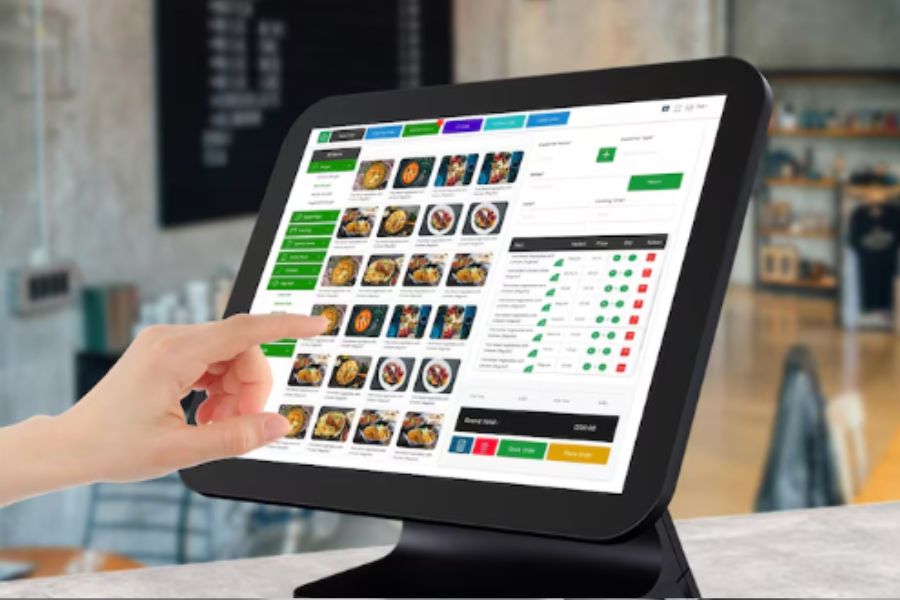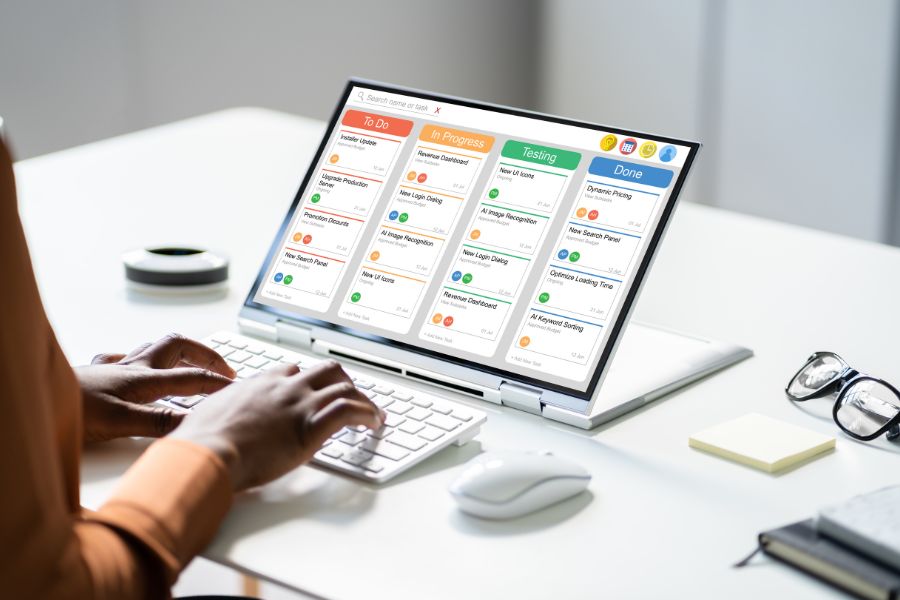For retail businesses, staying competitive means embracing innovation that enhances customers’ shopping experiences while optimizing operations. One such innovation that is making waves is the implementation of the endless aisle retail concept. This approach, facilitated by technology like ConnectPOS, allows retailers to extend their product offerings beyond the constraints of physical store space.
What Is Endless Aisle Retail?
Endless aisles refer to the virtual expansion of a retailer’s product inventory beyond the constraints of physical store space. They enable customers to browse and purchase products that may not be available in-store, accessing them through digital platforms such as websites or mobile apps.
Key components of endless aisle retail are:
- E-commerce Integration: Seamless integration with the retailer’s online platform allows customers to access a broader range of products.
- Real-Time Inventory Management: Advanced inventory systems provide accurate visibility into product availability across various channels.
- Omnichannel Experience: Endless aisles ensure a seamless shopping journey across online and offline touchpoints.
- Fulfillment Flexibility: Customers can choose from various fulfillment options, including home delivery, in-store pickup, or same-day delivery.
- Personalization: Data analytics enable personalized product recommendations and promotions tailored to individual customer preferences.
Pro Of Endless Aisles In Retail
Despite online sales comprising 20% of total retail sales, a certain number of shoppers still favor in-store purchases. Endless aisles expand customer options and simplify product discovery. Retailers benefit from increased sales by offering a broader product range and minimizing the requirement for physical store space to store inventory.
Increased Product Selection
The implementation of endless aisle retail revolutionizes the retail landscape by liberating businesses from the spatial constraints of physical stores. This expansive assortment caters to the multifaceted preferences of modern consumers, ensuring that shoppers have access to a wide array of options across various categories, brands, and price points.
This newfound freedom in product selection empowers retailers to cater to diverse consumer needs and preferences, ultimately driving engagement and loyalty. With endless aisles, retailers can transform their storefronts into virtual marketplaces, offering shoppers unparalleled convenience and choice and solidifying their position as leaders in the retail industry.
Higher Sales
The breadth and depth of product offerings facilitated by endless aisles not only enhance customer choice but also unlock vast potential for revenue growth. By expanding their product catalog beyond the confines of physical shelves, retailers create abundant opportunities for upselling and cross-selling. Sales associates can effectively recommend complementary items to customers, thereby maximizing each transaction’s value.
This strategic approach to sales not only increases sales volumes but also cultivates a culture of proactive engagement and personalized service. Consequently, the adoption of endless aisles becomes instrumental in driving higher sales revenue, solidifying the retailer’s position as a trusted destination for fulfilling diverse consumer needs.
Competitive advantage
Differentiation is key to maintaining relevance and capturing market share in a fiercely competitive retail landscape. Endless aisles are an effective tool that retailers can use to make themselves stand out. By offering a more extensive range of products than traditional brick-and-mortar stores, retailers with endless aisles can establish themselves as leaders in choice and convenience, which is something that customers value greatly.
This competitive edge resonates with consumers seeking comprehensive shopping experiences, thereby attracting a broader customer base and fostering stronger brand loyalty. Through continuous innovation and expansion of their product assortment, retailers can leverage endless aisles to fortify their market position and outshine rivals, ultimately achieving sustainable growth and success in the dynamic retail industry.
Lower inventory costs
Traditional inventory management poses significant challenges for retailers, from costly storage facilities to the risk of overstocking or stockouts. However, the adoption of endless aisles presents an opportunity to optimize inventory management and reduce associated costs.
Endless aisle retail tackles customer dissatisfaction with stockouts, which result in a 10% loss in sales, by providing an alternative solution that prevents customers from turning to competitors. Retailers can reduce their reliance on extensive physical inventory, leading to decreased storage costs and enhanced cash flow.
This agile approach to inventory management enhances operational efficiency and ensures that retailers can adapt swiftly to fluctuating demand and market trends. As a result, the integration of endless aisles becomes a strategic imperative for retailers seeking to optimize their inventory management practices, streamline operations, and maximize profitability in today’s dynamic retail landscape.
Customer understanding
Insights into customer behavior and preferences are invaluable for retailers seeking to tailor their offerings and marketing strategies effectively. Endless aisles serve as a rich source of customer data, providing retailers with valuable insights into browsing patterns, purchase history, and product preferences. Retailers can gain a comprehensive understanding of their customers’ needs and preferences.
By leveraging these insights, retailers can enhance the overall customer experience, foster stronger connections with their audience, and cultivate long-term loyalty. Thus, the integration of endless aisles not only expands product selection but also facilitates deeper customer engagement, positioning retailers for sustained success and growth in the competitive retail landscape.
Cons of Endless Aisles in Retail
Inventory management difficulties
While endless aisles offer a vast array of products, managing inventory across multiple channels can be challenging. Retailers must carefully track stock levels, synchronize inventory data, and prevent overselling or stockouts to maintain customer satisfaction.
Extra Cost
Implementing endless aisle retail often requires investment in technology infrastructure, such as robust e-commerce platforms and inventory management systems. Additionally, the cost of dropshipping or virtual inventory solutions may impact profit margins, especially for smaller retailers with limited resources.
Logistics
Fulfilling orders from endless aisles involves complex logistics, including shipping products from various suppliers or fulfillment centers to customers’ locations. Managing shipping costs, delivery times, and order tracking can pose logistical challenges for retailers, particularly during peak seasons or periods of high demand.
Implementation and data accuracy
Integrating endless aisles into existing retail operations requires careful planning and execution. Retailers must ensure the accuracy of product data, pricing, and availability across all channels to avoid customer dissatisfaction and operational inefficiencies. Maintaining data integrity and consistency can be labor-intensive and may require ongoing monitoring and updates.
Best practices for implementing endless aisle
Succeeding with an endless aisle retail strategy requires more than just having a mobile browser open to your website at the front counter. Consider these best practices:
Seamless System Integration
Integrating seamlessly with existing systems, such as your POS system, is essential for a successful endless aisle. Transactions conducted through the endless aisle must be processed with the same efficiency and security as in-store purchases, necessitating the use of the same payment processor.
By directly linking the endless aisle to your POS system, inventory updates and financial transactions are automatically synchronized, providing real-time visibility of stock levels and sales data. This synchronization minimizes discrepancies between online and in-store inventory, facilitating accurate order fulfillment and efficient customer order management.
User-friendly interface for customers
Creating a user-friendly interface is crucial for customer engagement with your endless aisle retail. Although backend efficiency is crucial, a clean and straightforward design ensures that customers can effortlessly navigate through your expanded inventory without feeling overwhelmed.
Key elements for a user-friendly interface include:
- Clear Categorization: Utilize consistent top-level categories and limit sub-categories to no more than ten per top-level category. For instance, organize by gender (or style) followed by a consistent sub-category system, or by clothing article type then style. This is particularly important when dealing with third-party vendors in your endless aisle.
- High-Quality Images: As the endless aisle connects customers to products they may not see in-store, provide multiple high-quality images to give them a comprehensive view of the product.
- Detailed Product Information: Ensure comprehensive product descriptions are available, allowing customers to make informed decisions. Include product comparisons and reviews to further aid in the decision-making process.
In-store employee knowledge and training
In-store employees play a crucial role in the success of the endless aisle strategy. They should possess a thorough knowledge of the system, enabling them to assist customers effectively and process orders seamlessly through the endless aisle platform.
This ensures a smooth and efficient customer experience, with employees poised to offer support and enrich the shopping journey.
Employee training should encompass:
- Technical proficiency: Every customer-facing employee should be well-versed in navigating the endless aisle kiosks, tablets, or QR codes. This ensures they can troubleshoot any technical issues promptly, enhancing the perception of the endless aisle as user-friendly and straightforward.
- Inventory expertise: In-depth knowledge of the product inventory showcased in the endless aisle is essential. Consistency in information between the platform and sales associates portrays professionalism and builds customer trust. Additionally, well-informed employees can make tailored product recommendations, alleviating choice paralysis and guiding shoppers effectively through the extensive inventory.
By providing comprehensive training on these aspects, retailers can empower their employees to deliver exceptional service and maximize the benefits of the endless aisle strategy.
Utilize data-driven insights
As with any in-store enhancement, refining the endless aisle retail is an iterative process that requires gathering and analyzing data to tailor product offerings, adapt placement strategies, and predict future trends.
For instance:
- Customer Behavior Analysis: Collect data on customer interactions with the endless aisle kiosk, including the frequency and duration of usage. Assess whether endless aisle shoppers spend more or less compared to traditional in-store shoppers. Analyze preferences for delivery versus in-store pickup to optimize fulfillment options.
- Purchase History Examination: Examine the purchase history of endless aisle customers to identify patterns and preferences. Determine if there are differences in purchasing behavior between endless aisle, in-store, and online shoppers.
- Search Trends Evaluation: Monitor search trends within the endless aisle platform to identify popular products or variants. Track the emergence of new search trends and adjust product offerings accordingly.
By leveraging data related to customer behavior, purchase history, and search trends, retailers can fine-tune their endless aisle offerings, prioritize high-demand products, implement targeted promotions, and ultimately enhance the overall shopping experience.
What Are The Benefits Of Implementing Endless Aisle With ConnectPOS?
Implementing the features on ConnectPOS as an endless aisle retail strategy offers several benefits for retailers:
- Seamless Integration: ConnectPOS seamlessly integrates with existing retail systems, ensuring smooth technical integration without disrupting operations.
- Inventory Transparency: ConnectPOS provides accurate inventory visibility across all channels, enabling retailers to effectively manage stock levels and prevent stockouts or overstock situations.
- Streamlined Processes: The platform simplifies complex processes like order fulfillment and returns management, enhancing operational efficiency and reducing manual errors.
- User-Friendly Interface: ConnectPOS offers a user-friendly interface that facilitates quick employee adaptation and training, minimizing the time and resources required for onboarding.
- Cost-Effective Setup: Despite the potential high initial setup costs associated with Endless Aisle strategies, ConnectPOS offers cost-effective solutions, making it accessible for retailers of all sizes.
- Supply Chain Management: ConnectPOS provides effective tools for supply chain management, enabling retailers to optimize their inventory management processes and ensure timely product availability.
- Data Security: ConnectPOS maintains high standards of data security and privacy, protecting sensitive customer information and ensuring compliance with regulations.
By leveraging ConnectPOS for Endless Aisle implementation, retailers can overcome the challenges associated with this strategy and achieve improved operational efficiency and customer satisfaction.
FAQs About Endless Aisles Retail
- What is an endless aisle kiosk?
An endless aisle kiosk is a self-service station within a retail store that allows customers to browse and purchase products that may not be physically available in-store. These kiosks typically feature digital screens or tablets connected to the retailer’s inventory database and online catalog, enabling customers to explore an extended range of products, place orders, and arrange for delivery or pickup.
- What is an example of an endless aisle retail?
An example of an endless aisle is a retail store that offers an extensive online catalog of products in addition to its in-store inventory. For instance, a clothing retailer may have a limited selection of sizes and styles available in-store but allows customers to access a broader range of options through its website or mobile app.
- How do retailers manage inventory for endless aisle products?
Retailers employ various strategies to manage inventory for endless aisle products effectively. One common approach is to implement real-time inventory synchronization between the online and offline channels. This involves integrating the retailer’s inventory management system with its e-commerce platform to ensure that product availability and stock levels are updated in real-time across all channels.
Conclusion
The endless aisle retail presents both opportunities and challenges for businesses looking to stay ahead in retail. By leveraging its potential benefits, such as expanded product range, enhanced customer experiences, and improved inventory management, retailers can create a competitive edge and drive growth.
To explore how you can implement endless aisle with ConnectPOS, don’t hesitate to contact us.



